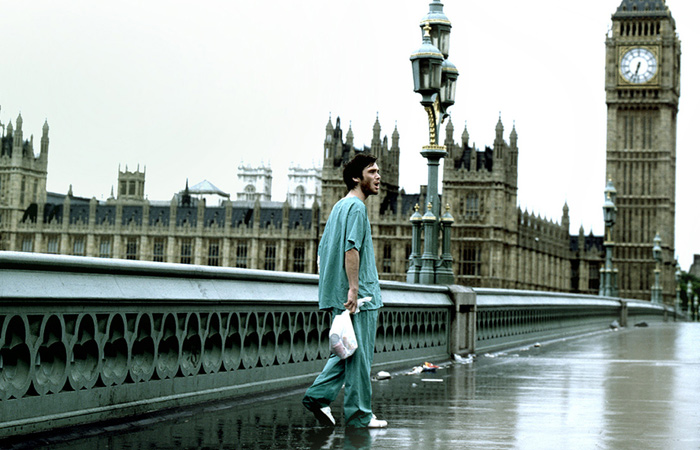28 Days Later (2003)

I’m not going to bother trying to figure out all of the things which make little or no sense during 28 Days Later, as they are not only impossible to explain given the little information we are given but even some of the things which we know make no real sense at all. What I can tell you is that the film, for all of its flaws in the plausibility department, is a success in delivering tension consistently with intelligence and emotion. It is almost a thematic re-invention of a previous Danny Boyle film, and one which was much more flawed in the dramatic department, The Beach. It shouldn’t come as a surprise to know that the author of the book on which The Beach is based, Alex Garland, would be the screenwriter for 28 Days Later, and by Boyle sticking closer to the source material, a much more effective result has been achieved.
The initial scene of 28 Days Later involves the infiltration of an animal testing center by a group of militant animal activists, who, in their quest for animal freedom, unknowingly release a monkey infected with a virus which induces mindless rage. This virus spreads through the ingestion of the blood of an infected person. Within mere seconds of being infected, a human being will turn into a ravenous zombie, which only has one desire: to seek and infect others who do not have the virus.
The next scene pushes us ahead twenty-eight days, where Jim (Murphy) awakens from a coma only to find himself alone, not just in the room, but the world as far as he can see. The world has radically changed, now that the streets are deserted, and the only human contact seems to come from the occasional rage-filled murderer. Later, he finds that he isn’t alone and that others haven’t yet been afflicted by the rage, and they form a band to combat the infected in the quest for survival.
As mentioned in the first paragraph, 28 Days Later is similar to Boyle and Garland’s previous work, The Beach, in that it explores the dangers humans face, not only from total anarchy but from totalitarianism as well. It delves into what would happen when humans succumb to their basest instincts, or as Freud would say our Ids, and in a poignant series of events, also explores the fact that the ability to be infused with rage is inherent in every human, whether infected with a virus or not. Rage is everywhere, in everyone, and the human race is killing itself as a result. There are subtexts of Darwin’s “Survival of the Fittest” throughout 28 Days Later, but also an irony that the more technologically advanced we become, i.e., the less dependent on nature, the more likely human society is to collapse into anger and fear. From road rage on the highways to corporate office shooting sprees, people out there are just a push away from cracking under pressure into the mindless killing of their own.
Danny Boyle does an excellent job directing a very competent troupe of actors. Although some may find the jump-cut nature of the attacks unsettling (and possibly annoying), I thought it was beneficial because it not only showed the mindset of the infected but also the point-of-view of the person being attacked. There are many impressive scenes of a deserted London, which is a both a strength and a weakness, because visions of an empty road make us feel diminished while at the same time makes us wonder why there are so few stranded vehicles littering the area, especially if mass hysteria and a rapidly spreading virus were to hit the place in a heartbeat. The film goes into high gear later changing from sci-fi/horror to more of an action film, but during these scenes, the momentum seems to break apart, and the focus blurs. Despite the turbulence, the story holds itself together because, in the end, we do care about the characters and what happens to them.
28 Days Later leaves many questions unanswered, many ideas unexplained, and doesn’t hold up to scientific scrutiny. It requires a good deal of suspension of disbelief and a willingness to give the creators the benefit of the doubt. It is recommended for fans of post-apocalyptic science fiction, zombie flicks, and those who have been disillusioned with the paltry amounts of intelligent horror films to come out in recent years. Yes, it’s complete nonsense, but utterly riveting at the same time.
Qwipster’s rating: A
MPAA Rated: R for strong violence, gore, language and nudity
Running time: 112 min.
Cast: Cillian Murphy, Naomie Harris, Megan Burns, Brendan Gleeson, Noah Huntley, Luke Mably
Director: Danny Boyle
Screenplay: Alex Garland
